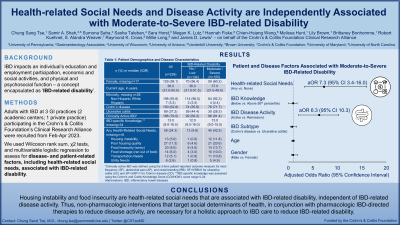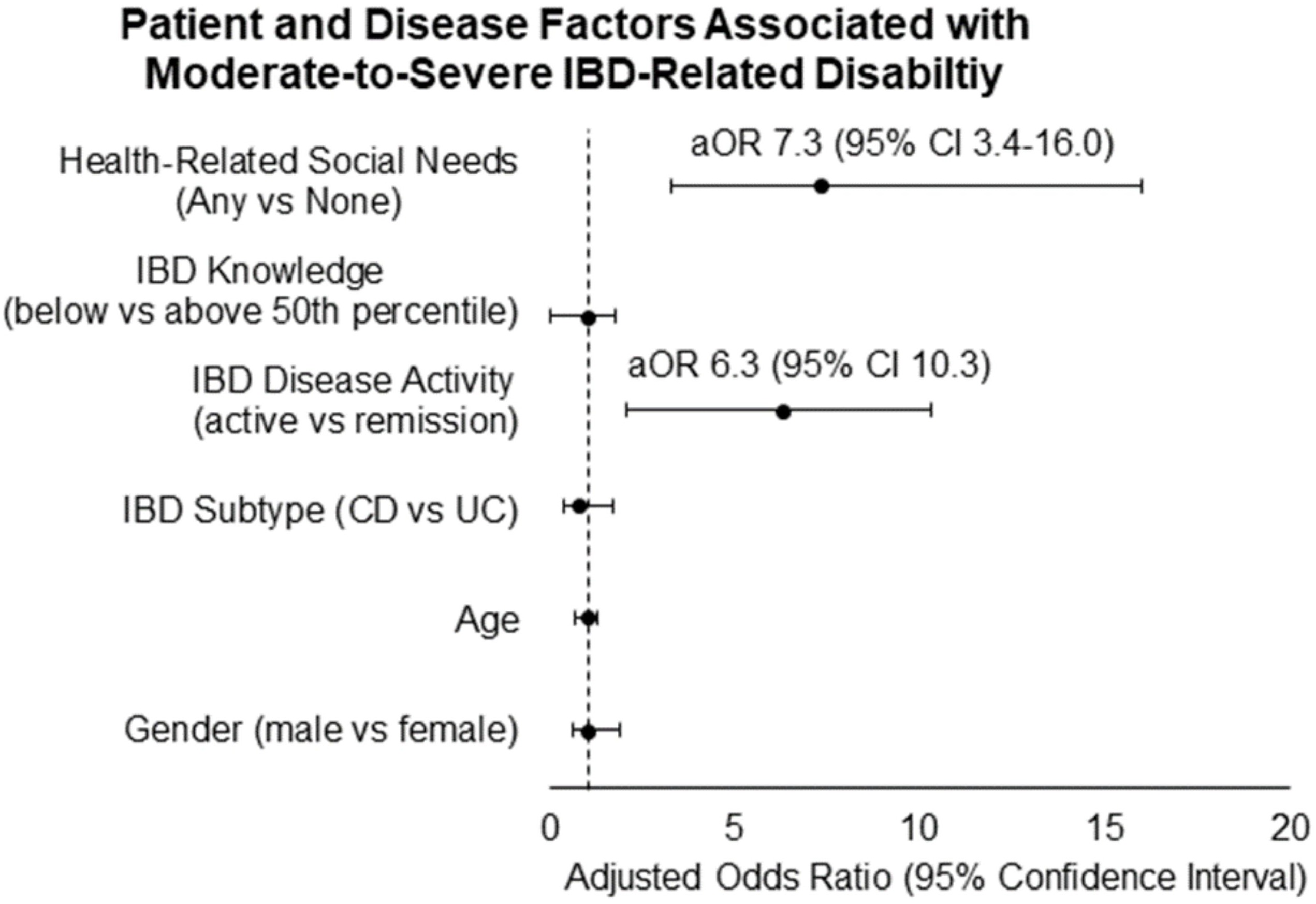Sunday Poster Session
Category: IBD
P0710 - Health-Related Social Needs & Disease Activity Are Independently Associated With Moderate-to-Severe IBD-Related Disability
Sunday, October 22, 2023
3:30 PM - 7:00 PM PT
Location: Exhibit Hall

Has Audio

Chung Sang Tse, MD
University of Pennsylvania
Philadelphia, PA
Presenting Author(s)
Chung Sang Tse, MD1, Samir A. Shah, MD, FACG2, Sumona Saha, MD3, Sasha Taleban, MD4, Sara Horst, MD, MPH5, Megan Lutz, MD6, Hannah Fiske, MD7, Chien-Hsiang Weng, MD, MPH7, Melissa G.. Hunt, PhD1, Lily Brown, PhD1, Brittaney Bonhomme, BS1, Robert Kuehnel, PhD8, Alandra Weaver, MPH9, Raymond Cross, MD10, Millie D. Long, MD, MPH11, James Lewis, MD, MSCE1
1University of Pennsylvania, Philadelphia, PA; 2Gastroenterology Associates, Inc., Providence, RI; 3University of Wisconsin, Milwaukee, WI; 4University of Arizona College of Medicine, Tucson, AZ; 5Vanderbilt University Medical Center, Nashville, TN; 6University of Wisconsin, Milaukee, WA; 7Brown University, Providence, RI; 8Lafayette, NY; 9Crohn's and Colitis Foundation, New York, NY; 10University of Maryland, Baltimore, MD; 11UNC Chapel Hill, Chapel Hill, NC
Introduction: IBD impacts an individual’s education and employment participation, economic and social activities, and physical and psychosocial function – a concept encapsulated as ‘IBD-related disability’. We aim to identify disease- and patient-related factors, including health-related social needs, associated with IBD-related disability.
Methods: We surveyed adults with IBD at 3 GI practices (2 academic centers; 1 private community practice) from Feb-Apr 2023. To identify patient/disease factors associated with moderate-to-severe IBD-related disability (vs. no/low disability, measured by the IBD Disability Index), we used Wilcoxon rank sum or χ2 tests and logistic regression models with variables determined a priori: gender, age, IBD subtype, IBD disease activity (2-item patient-reported outcome, PRO-2), IBD knowledge (Crohn’s and Colitis Knowledge Score), and health-related social needs across 4 domains of housing instability, food security, transportation needs, and utility needs (Centers for Medicare & Medicaid Services Health-Related Social Needs Screening Tool).
Results: Of the 239 adults with IBD surveyed (63% CD, 37% UC; 79% active, 21% remission; median age 36 years; 58% female; 85% White, 9% Black; 87% post-secondary education; 80% working/studying; 61% married), nearly half (44%) had moderate-to-severe IBD-related disability (Tab 1). Over one-fifth (23%) of patients have at least one health-related social need (mean 0.4, 95% CI 0.3-0.5); poor housing quality (12%) and food insecurity (9%) were the most common.
On multivariable analysis, active disease (aOR 6.3, 95% CI 2.1-10.3) and health-related social needs (any vs. none: aOR 7.3, 95% CI 3.4-16.0) were independently associated with moderate-to-severe IBD-related disability, but gender, age, IBD subtype, and IBD-specific knowledge were not (Fig 1). The presence of each health-related social need was associated with a 3-fold increased risk for moderate-to-severe IBD-related disability (aOR 3.1, 95% CI 1.8-5.3).
Discussion: IBD disease activity and health-related social needs are independently associated with IBD-related disability. Housing instability and food insecurity are independently associated with a 3-fold risk for IBD-related disability. Pharmacologic IBD-directed therapies to reduce disease activity and non-pharmacologic interventions that target social determinants of health are both necessary for a holistic approach to IBD care to reduce the overall burden of IBD disability.

Disclosures:
Chung Sang Tse, MD1, Samir A. Shah, MD, FACG2, Sumona Saha, MD3, Sasha Taleban, MD4, Sara Horst, MD, MPH5, Megan Lutz, MD6, Hannah Fiske, MD7, Chien-Hsiang Weng, MD, MPH7, Melissa G.. Hunt, PhD1, Lily Brown, PhD1, Brittaney Bonhomme, BS1, Robert Kuehnel, PhD8, Alandra Weaver, MPH9, Raymond Cross, MD10, Millie D. Long, MD, MPH11, James Lewis, MD, MSCE1. P0710 - Health-Related Social Needs & Disease Activity Are Independently Associated With Moderate-to-Severe IBD-Related Disability, ACG 2023 Annual Scientific Meeting Abstracts. Vancouver, BC, Canada: American College of Gastroenterology.
1University of Pennsylvania, Philadelphia, PA; 2Gastroenterology Associates, Inc., Providence, RI; 3University of Wisconsin, Milwaukee, WI; 4University of Arizona College of Medicine, Tucson, AZ; 5Vanderbilt University Medical Center, Nashville, TN; 6University of Wisconsin, Milaukee, WA; 7Brown University, Providence, RI; 8Lafayette, NY; 9Crohn's and Colitis Foundation, New York, NY; 10University of Maryland, Baltimore, MD; 11UNC Chapel Hill, Chapel Hill, NC
Introduction: IBD impacts an individual’s education and employment participation, economic and social activities, and physical and psychosocial function – a concept encapsulated as ‘IBD-related disability’. We aim to identify disease- and patient-related factors, including health-related social needs, associated with IBD-related disability.
Methods: We surveyed adults with IBD at 3 GI practices (2 academic centers; 1 private community practice) from Feb-Apr 2023. To identify patient/disease factors associated with moderate-to-severe IBD-related disability (vs. no/low disability, measured by the IBD Disability Index), we used Wilcoxon rank sum or χ2 tests and logistic regression models with variables determined a priori: gender, age, IBD subtype, IBD disease activity (2-item patient-reported outcome, PRO-2), IBD knowledge (Crohn’s and Colitis Knowledge Score), and health-related social needs across 4 domains of housing instability, food security, transportation needs, and utility needs (Centers for Medicare & Medicaid Services Health-Related Social Needs Screening Tool).
Results: Of the 239 adults with IBD surveyed (63% CD, 37% UC; 79% active, 21% remission; median age 36 years; 58% female; 85% White, 9% Black; 87% post-secondary education; 80% working/studying; 61% married), nearly half (44%) had moderate-to-severe IBD-related disability (Tab 1). Over one-fifth (23%) of patients have at least one health-related social need (mean 0.4, 95% CI 0.3-0.5); poor housing quality (12%) and food insecurity (9%) were the most common.
On multivariable analysis, active disease (aOR 6.3, 95% CI 2.1-10.3) and health-related social needs (any vs. none: aOR 7.3, 95% CI 3.4-16.0) were independently associated with moderate-to-severe IBD-related disability, but gender, age, IBD subtype, and IBD-specific knowledge were not (Fig 1). The presence of each health-related social need was associated with a 3-fold increased risk for moderate-to-severe IBD-related disability (aOR 3.1, 95% CI 1.8-5.3).
Discussion: IBD disease activity and health-related social needs are independently associated with IBD-related disability. Housing instability and food insecurity are independently associated with a 3-fold risk for IBD-related disability. Pharmacologic IBD-directed therapies to reduce disease activity and non-pharmacologic interventions that target social determinants of health are both necessary for a holistic approach to IBD care to reduce the overall burden of IBD disability.

Figure: Figure 1: Multivariate Logistic Regression of Patient and Disease Factors Associated with Moderate-to-Severe IBD-Related Disability
Abbreviations: aOR, adjusted odds ratio; CD, Crohn’s disease; CI, confidence interval; IBD, inflammatory bowel diseases; UC, ulcerative colitis
Abbreviations: aOR, adjusted odds ratio; CD, Crohn’s disease; CI, confidence interval; IBD, inflammatory bowel diseases; UC, ulcerative colitis
Table: Table 1: Patient Demographics and Disease Characteristics
Abbreviations: IBD; inflammatory bowel diseases; IQR, interquartile range
*IBD remission was defined using the 2-item patient-reported outcome measure (PRO-2) for stool frequency (SF), abdominal pain (AP), and rectal bleeding (RB): SF=0/RB=0 for ulcerative colitis (UC) and SF≤3/AP≤1 for Crohn’s disease (CD).
Abbreviations: IBD; inflammatory bowel diseases; IQR, interquartile range
*IBD remission was defined using the 2-item patient-reported outcome measure (PRO-2) for stool frequency (SF), abdominal pain (AP), and rectal bleeding (RB): SF=0/RB=0 for ulcerative colitis (UC) and SF≤3/AP≤1 for Crohn’s disease (CD).
Disclosures:
Chung Sang Tse indicated no relevant financial relationships.
Samir Shah indicated no relevant financial relationships.
Sumona Saha indicated no relevant financial relationships.
Sasha Taleban indicated no relevant financial relationships.
Sara Horst: Abbvie – Advisory Committee/Board Member, Consultant. Gilead – Advisory Committee/Board Member, Consultant. Janssen – Advisory Committee/Board Member, Consultant. Takeda – Advisory Committee/Board Member, Consultant. USB – Advisory Committee/Board Member, Consultant.
Megan Lutz indicated no relevant financial relationships.
Hannah Fiske indicated no relevant financial relationships.
Chien-Hsiang Weng indicated no relevant financial relationships.
Melissa Hunt indicated no relevant financial relationships.
Lily Brown indicated no relevant financial relationships.
Brittaney Bonhomme indicated no relevant financial relationships.
Robert Kuehnel indicated no relevant financial relationships.
Alandra Weaver indicated no relevant financial relationships.
Raymond Cross: Abbvie – Advisory Committee/Board Member, Consultant. Adiso – Advisory Committee/Board Member. BMS – Advisory Committee/Board Member. CorEvitas Registry – Scientific co-director. Frensenius Kabi – Advisory Committee/Board Member, Consultant. Fzata – Consultant. IBD Executive Group – Advisory Committee/Board Member. Janssen – Advisory Committee/Board Member, Grant/Research Support. Magellan Health – Consultant. Pfizer – Advisory Committee/Board Member, Consultant. Samsung bioepis – Consultant. Sebela – Advisory Committee/Board Member, Consultant. Takeda – Advisory Committee/Board Member.
Millie D. Long: AbbVie – Consultant. Bristol Myers Squibb – Consultant. Eli Lilly – Consultant, Grant/Research Support. Genentech – Consultant. Intercept – Consultant. Janssen – Consultant. Pfizer – Consultant, Grant/Research Support. Prometheus – Consultant. Roche – Consultant. Salix – Consultant. Takeda – Consultant, Grant/Research Support. Target PharmaSolutions – Consultant. UCB – Consultant. Valeant – Consultant.
James Lewis: AbbVie – Consultant, Grant/Research Support. Amgen – Advisor or Review Panel Member. Arena Pharmaceuticals – Advisor or Review Panel Member. Bridge Biotherapeutics – Consultant. Celgene / BMS – Consultant. Dark Canyon Laboratories – Consultant. Dark Canyon Laboratories – Consultant, Stock-privately held company. Entasis Therapeutics – Consultant. Galapagos – Advisory Committee/Board Member. Gilead – Advisor or Review Panel Member. Janssen Pharmaceuticals – Consultant, Grant/Research Support. Merck – Consultant. Multiple manufactures of generic ranitidine – expert witness. Nestle Health Science – Consultant, Grant/Research Support. Pfizer – Advisor or Review Panel Member. Protagonist Therapeutics – Advisory Committee/Board Member. Sanofi – Advisor or Review Panel Member. Scipher Medicine – Consultant. Takeda – Grant/Research Support.
Chung Sang Tse, MD1, Samir A. Shah, MD, FACG2, Sumona Saha, MD3, Sasha Taleban, MD4, Sara Horst, MD, MPH5, Megan Lutz, MD6, Hannah Fiske, MD7, Chien-Hsiang Weng, MD, MPH7, Melissa G.. Hunt, PhD1, Lily Brown, PhD1, Brittaney Bonhomme, BS1, Robert Kuehnel, PhD8, Alandra Weaver, MPH9, Raymond Cross, MD10, Millie D. Long, MD, MPH11, James Lewis, MD, MSCE1. P0710 - Health-Related Social Needs & Disease Activity Are Independently Associated With Moderate-to-Severe IBD-Related Disability, ACG 2023 Annual Scientific Meeting Abstracts. Vancouver, BC, Canada: American College of Gastroenterology.
